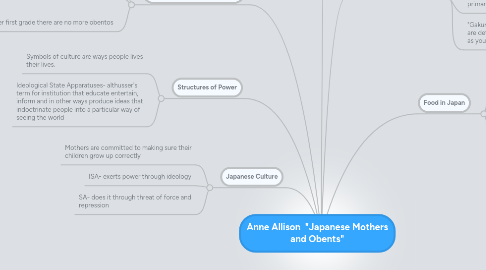Anne Allison "Japanese Mothers and Obents"
by Latanya Bramwell

1. Structures of Power
1.1. Symbols of culture are ways people lives their lives.
1.2. Ideological State Apparatuses- althusser's term for institution that educate entertain, inform and in other ways produce ideas that indoctrinate people into a particular way of seeing the world
2. Nursery School and Ideological Appropriation of the Obento
2.1. Children are more comfortable
2.2. Shows the commitment of mothers
2.2.1. Japanese mothers spend an average of 20-45 minutes every morning cooking, assembling and preparing the contents of one Obento for nursery age children
2.3. After first grade there are no more obentos
2.3.1. The greatest portion of 3-6 year old that goes to school.
2.3.1.1. Sets up children for a higher education.
3. Japanese Culture
3.1. Mothers are committed to making sure their children grow up correctly
3.2. ISA- exerts power through ideology
3.3. SA- does it through threat of force and repression
4. Obento
4.1. Creating the Obento is the most worrisome concern facing the mother of a child going off to school
4.2. A boxed lunch for nursery school children going off to school for the first time
4.3. Lunch contains a decent amount of food
4.4. The state manipulates meanings of the Obento indirectly
4.5. Students are expected to eat all their lunch
5. Food in Japan
5.1. Food must be perfectly prepared
5.2. No food is just food
5.3. The container is almost as important as the food
5.4. Food should first look good then taste good
6. School, State, Subjectivity
6.1. The purpose of school is to shape children into proper gender roles
6.2. If they are able to be obedient to their parents and teachers, children are required to be obedient to the state
6.3. In Japan it is the school which assumes the primary role of ideological state apparatus
6.4. "Gakureki Shakkal" where careers of adults are determined by the schools they attend as youths.


